A brisk five-minute walk from the Naihati railway station is the abode of one of the most opulent idols of goddess Kali anywhere in West Bengal. Standing at a height of 22 feet and venerated for the last 94 years, Naihati’s most famous manifestation of Kali is unanimously hailed by locals as Boro Maa.
Built over 15 days (with the foundation of the idol being laid on Lakshmi Puja) and decked in 12 kilograms of gold and 200 kilograms of silver, Boro Maa draws thousands of devotees each year, with pre-pandemic numbers surging close to 60,000 on the days of Kali Puja and Diwali.
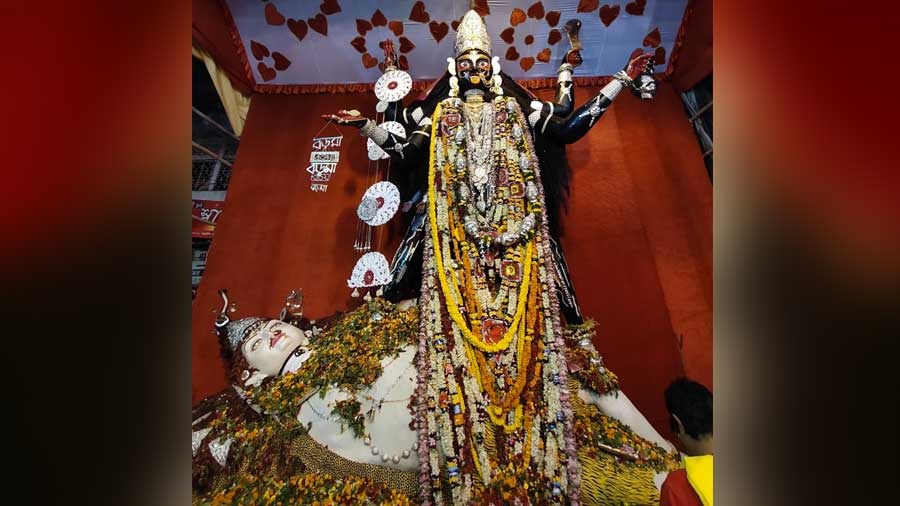
The massive 22-foot-tall idol of Boro Maa Ritagnik Bhattacharya
In West Bengal, Kali, the goddess of time and death, is usually softened into the image of a protective mother figure and the bestower of maternal care and benevolence. This is reflected in the domesticated and benign Dakshina or Shyama Kali, who is distinguished by her blue skin. Naihati’s Boro Maa, though, is representative of another type of Kali, the pitch-dark Raksha or Shamshan Kali, symbolising destruction and renewal.
About a century ago, a young man named Bhavesh Chakraborty went to experience Bhanga Rash at Nabadwip accompanied by four friends. The incredible heights of the idols in Nabadwip made for a spectacle none of them could forget. After returning to Naihati, Chakraborty had a dream where Kali, at the time a small deity of the family, instructed him to mould her into a gigantic idol, similar to the ones in Nabadwip.
Soon enough, Naihati’s Boro Maa was conceived.

Boro Maa is decked up in 12 kilograms of gold and 200 kilograms of silver every year Ritagnik Bhattacharya
As Boro Maa’s popularity soared over the years, the puja was opened up to the general public (towards the end of the last century) and stopped remaining confined to the Chakraborty household.
“People come here not only from all corners of West Bengal, but also from different parts of India like Assam and Meghalaya. We even get visitors from Bangladesh,” observes Swapan Dutta, secretary of the Naihati Boro Maa Pujo Samiti.
For five days each year, Boro Maa, whose lotus eyes exude a sense of controlled rage, is decorated in grand fashion and worshipped in adherence to the traditions first established by Bhavesh Chakraborty. In keeping with Chakraborty’s wishes, no money is collected from locals to organise the Puja. Whatever sum devotees contribute voluntarily is what the Puja Samiti works with.

The lotus eyes of Boro Maa exude a sense of controlled rage Ritagnik Bhattacharya
Around 4,000 people are fed as part of the Puja annually, with a group of 15 to 20 cooks preparing all the meals. The bhog that is offered to Boro Maa herself always comes from the family of Bhavesh Chakraborty.
About a stone’s throw away from the glittering pandal that houses Boro Maa’s magnificent idol is a temple where a smaller avatar of Boro Maa is present all-year round. Painted in pink and yellow, the temple is relatively new (opened in 2014), with a sizable courtyard for devotees to space themselves out while offering their prayers.
A narrow aisle at one corner of the temple opens into a big, wide space where the meals for devotees are cooked, next to a small idol of the goddess Shitala.
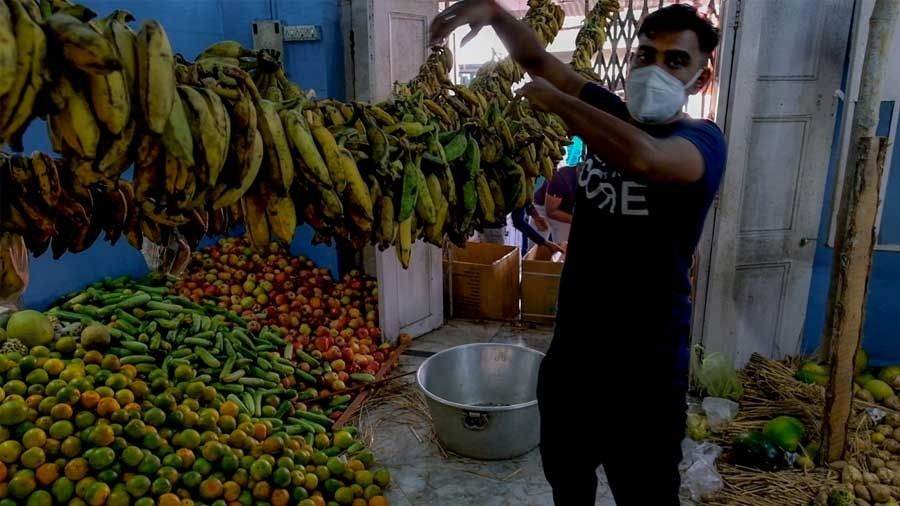
Bananas being arranged in rows in front of Radha and Krishna Ritagnik Bhattacharya
Opposite this aisle is another passage that leads to a quaint room for Radha and Krishna, whose floor is inundated with fruits, chiefly oranges and apples. Two parallel rows of bananas create a unique swing-like structure that sways in front of the idols in one of the more peculiar sights in the vicinity.
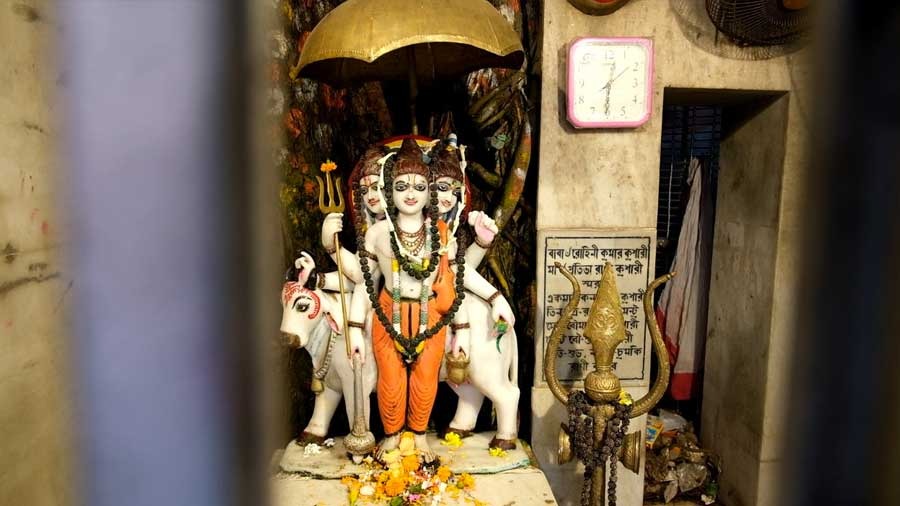
The three-headed Shiva at the Trinath temple Ritagnik Bhattacharya
Outside the premises of the Boro Maa temple is a shelter for Shiva at the Trinath temple, where Shiva appears in a rare three-headed avatar. The stoic Shiva in Trinath is in sharp contrast to the mesmerised expression that punctuates Shiva’s gaze when lying underneath Boro Maa a few feet away.
Kali Puja in Naihati begins and ends with Boro Maa.
On the day of bisharjan, which is set for November 7 this year, practically the whole of Naihati comes together to bid farewell to Boro Maa. Before 1970, the massive idol was carried on the shoulders of the strongest men in town, all the way from the pandal to the nearby Ganga for immersion. After 1970, the organisers thought better and decided to wheel Boro Maa to the river.
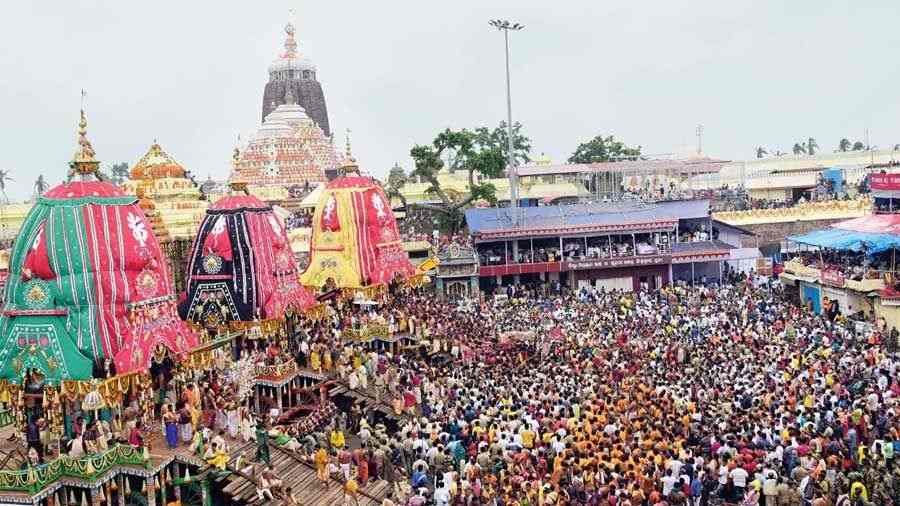
Scenes from Puri's Rath Yatra. During 'bisharjan', with the feverish atmosphere resembles the frenzy in Puri Ritagnik Bhattacharya
The sheer chaos and passion that flows in honour of Boro Maa is best illustrated during bisharjan, with the feverish atmosphere resembling the Rath Yatra frenzy in Puri.
The devotion of Boro Maa’s faithful notwithstanding, little thought seems to have been given to the environmental impact of immersing a 22-foot idol in the Ganga year upon year.
“The wooden structure that forms the building blocks of the idol is detached, the jewellery is taken off and Boro Maa is peacefully submerged,” says Dutta. When asked about the environmental impact, he says, “We only immerse the idol during high tide.” But how that makes a difference remains unclear.
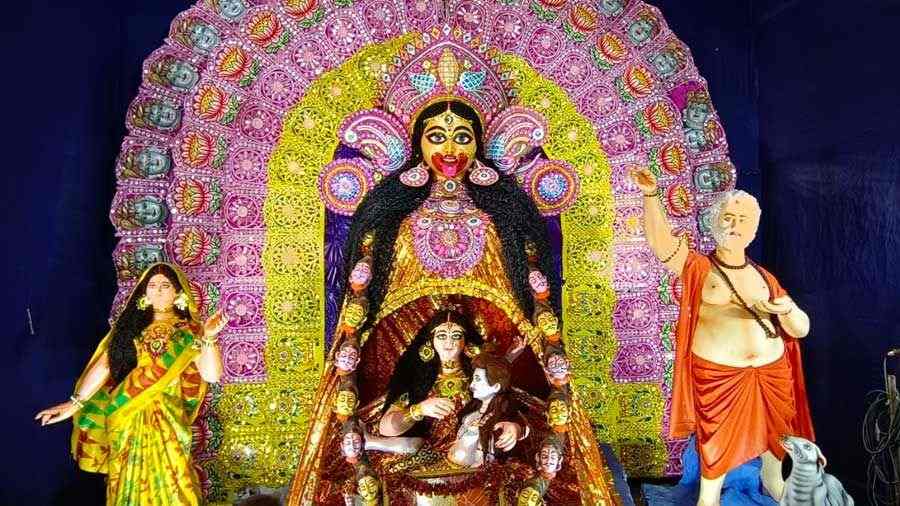
An innovative Kali idol at the Naihati Tematha Babsayi Samiti, about half a kilometre away from Boro Maa Ritagnik Bhattacharya
No matter the consequences of letting Boro Maa loose in the Ganga, most devotees are convinced that Boro Maa can do nature and humans no harm.
“If you pray for something from the bottom of your heart, Boro Maa will oblige you. She is all-powerful,” says Shikha Das, 45, a resident of Prasad Nagar, who comes to the Boro Maa Pujo every year.
This year Das has decided to go one step further by performing the dandi kata, which involves crawling on the ground from the banks of the Ganga to the idol of Boro Maa in the pandal.

Shikha Das performing the 'dandi kata' Ritagnik Bhattacharya
Upon completing the exhausting act of submission, Das rises to her feet, gleaming. She adds: “This was my first time with the dandi. I sincerely hope Boro Maa will grant my wishes. She is known to do so for everyone.”